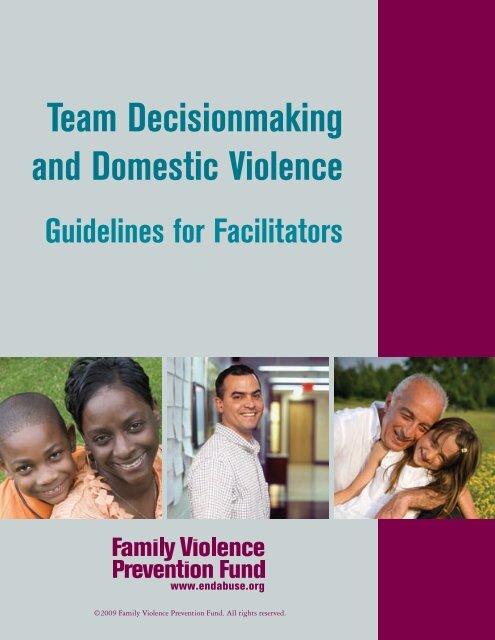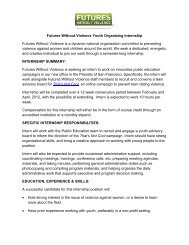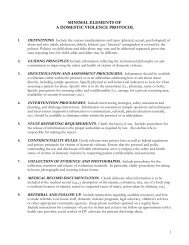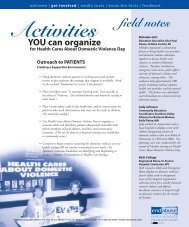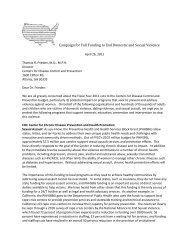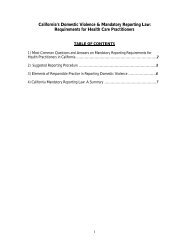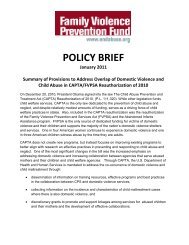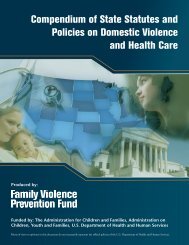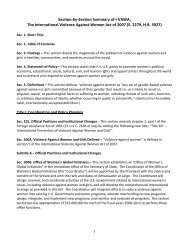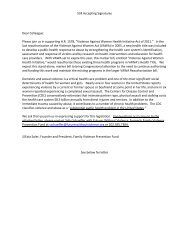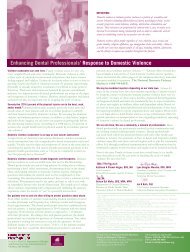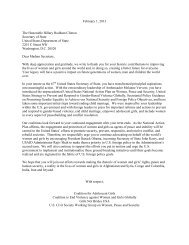Team Decisionmaking and Domestic Violence: Guidelines for ...
Team Decisionmaking and Domestic Violence: Guidelines for ...
Team Decisionmaking and Domestic Violence: Guidelines for ...
Create successful ePaper yourself
Turn your PDF publications into a flip-book with our unique Google optimized e-Paper software.
<strong>Team</strong> <strong>Decisionmaking</strong><br />
<strong>and</strong> <strong>Domestic</strong> <strong>Violence</strong><br />
<strong>Guidelines</strong> <strong>for</strong> Facilitators<br />
www.endabuse.org<br />
©2009 Family <strong>Violence</strong> Prevention Fund. All rights reserved.
<strong>Team</strong> <strong>Decisionmaking</strong><br />
<strong>and</strong> <strong>Domestic</strong> <strong>Violence</strong><br />
<strong>Guidelines</strong> <strong>for</strong> Facilitators<br />
Prepared <strong>for</strong> the Family <strong>Violence</strong> Prevention Fund by<br />
Shellie Taggart<br />
www.endabuse.org<br />
©2009 Family <strong>Violence</strong> Prevention Fund. All rights reserved.
Acknowledgements<br />
The guidelines <strong>for</strong> TDM facilitators were developed through a collaborative ef<strong>for</strong>t with<br />
many individuals, including <strong>Team</strong> <strong>Decisionmaking</strong> facilitators, supervisors, <strong>and</strong> schedulers<br />
in San Francisco, Cali<strong>for</strong>nia <strong>and</strong> Macomb County, Michigan. Valerie Veza, Lesha Taylor,<br />
Lourdes Rodriguez—we thank you all <strong>for</strong> your thoughtful contributions to this work.<br />
Fatima Jury, Thomas McGeorge, Inga Patton, Cindy Rush, Lynette Wright, Demetrius<br />
Starling, <strong>and</strong> Dave Buscher—we had the added benefit <strong>and</strong> privilege of spending two days<br />
with you in San Francisco exploring these strategies <strong>and</strong> engaging in a rich discussion<br />
about the impact of systems on families. Your insights <strong>and</strong> passion both inspired us <strong>and</strong><br />
gave us great hope <strong>for</strong> the future of child welfare.<br />
Last but not least we want to thank The Annie E. Casey Foundation <strong>for</strong> their generous support<br />
<strong>and</strong> guidance. We especially want to thank Pat Rideout <strong>and</strong> Bill Bettencourt, senior<br />
members of the Technical Assistance team at The Annie E. Casey Foundation, <strong>for</strong> their<br />
leadership <strong>and</strong> sensitivity on the issue of domestic violence <strong>and</strong> its impact on families in<br />
the child welfare system.<br />
Lonna Davis, Project Director Shellie Taggart, Author
Introduction<br />
A child’s exposure to domestic violence (DV) can create psychological <strong>and</strong> emotional problems<br />
such as aggression, hostility, anxiety, social withdrawal, depression, cognitive problems<br />
such as lower verbal <strong>and</strong> quantitative skills, <strong>and</strong> the development of attitudes supporting<br />
the use of violence (Edelson, 1999). A large number of children, however, appear<br />
not to be significantly affected (Graham-Bermann, 2001; Hughes & Luke, 1998; Grych,<br />
Jouriles, Swank, McDonald, & Norwood, 2000). While research on children’s resilience is<br />
relatively new, some research has shown that the most critical protective factor against the<br />
negative effects of a child’s exposure to violence is a relationship with a competent <strong>and</strong> caring<br />
adult (Margolin, 1998).<br />
In a DV situation, this relationship is most often with the non-offending parent who is<br />
surviving DV <strong>and</strong> employing safety strategies to protect her child (Bancroft & Silverman,<br />
2002). When physical safety can be assured, the bond between parent <strong>and</strong> child must be<br />
preserved <strong>and</strong> strengthened to promote the emotional safety <strong>and</strong> well-being of the child<br />
(Annie E. Casey, 2004). There<strong>for</strong>e, the focus of a child protection intervention should be to<br />
establish <strong>and</strong> maintain safety <strong>for</strong> the non-offending parent <strong>and</strong> child together by holding<br />
the perpetrator of violence accountable <strong>for</strong> his behavior <strong>and</strong> engaging him to change that<br />
behavior. When ef<strong>for</strong>ts by social workers to accomplish these goals cannot assure safety, a<br />
<strong>Team</strong> <strong>Decisionmaking</strong> (TDM) meeting may be held to determine whether removing the<br />
child from the care of her/his parent(s) is necessary.<br />
The quality of the decision that results from a TDM meeting involving DV is directly correlated<br />
to: 1) how skillfully DV has been addressed up to the point at which the meeting<br />
is held; 2) how safely the meeting is conducted; <strong>and</strong> 3) who participates in the meeting.<br />
Strategies <strong>for</strong> addressing DV in child protection practice have been documented in a variety<br />
of tools <strong>and</strong> studies. To conduct safe TDM meetings in these circumstances, In the Moment<br />
Strategies (Annie E. Casey, 2004) guides workers <strong>and</strong> TDM staff to consider holding separate<br />
meetings <strong>for</strong> DV perpetrators <strong>and</strong> non-offending parents, or including the<br />
perpetrator in the meeting by phone or through a proxy such as a family member. It further<br />
guides workers <strong>and</strong> TDM staff to conduct pre-TDM meeting planning <strong>and</strong> postmeeting<br />
safety checks with mothers. As a general rule, perpetrators of intimate partner<br />
violence <strong>and</strong> non-offending parents cannot be safely brought into a meeting together <strong>for</strong> an<br />
open discussion about the violence.<br />
<strong>Team</strong> <strong>Decisionmaking</strong> <strong>and</strong> <strong>Domestic</strong> <strong>Violence</strong>: <strong>Guidelines</strong> <strong>for</strong> Facilitators<br />
3
TDM meetings can be effective <strong>for</strong>ums <strong>for</strong> ensuring that resources <strong>and</strong> support are in place<br />
<strong>for</strong> the non-offending parent. In some cases, TDM meetings can also be effective <strong>for</strong> engaging<br />
a man who uses violence as a father in order to motivate him to change his behavior. To<br />
maximize success of the TDM meeting strategy, the facilitator can:<br />
• Develop her or his own skills in managing meetings involving intimate partner violence<br />
<strong>and</strong> assessing DV.<br />
• Allow time be<strong>for</strong>e <strong>and</strong> after the meeting to check in with participants about safety.<br />
• Be prepared with In the Moment Strategies in case DV is identified or suspected <strong>for</strong> the<br />
first time in the TDM meeting.<br />
• Have resource materials <strong>and</strong> in<strong>for</strong>mation available <strong>for</strong> both the non-offending parent<br />
<strong>and</strong> perpetrator.<br />
• Guide assessments of the suitability of potential relative caregivers who participate in<br />
TDM meetings.<br />
• Model engagement <strong>and</strong> accountability of men who use violence <strong>for</strong> workers <strong>and</strong> other<br />
participants.<br />
This paper is intended to help TDM facilitators practice more effectively by laying a<br />
foundation <strong>for</strong> safe meetings in DV situations (Safety St<strong>and</strong>ards <strong>and</strong> Strategies), suggesting<br />
topics <strong>for</strong> exploration in the meeting itself (<strong>Domestic</strong> <strong>Violence</strong> Assessment Issues),<br />
<strong>and</strong> providing concrete suggestions <strong>for</strong> interacting with both the non-offending parent<br />
<strong>and</strong> perpetrator of violence (Helpful Things to Say). Throughout this paper you will see<br />
the use of gendered pronouns. While both women <strong>and</strong> men can be victims of DV, women<br />
are more often the victims <strong>and</strong> suffer more serious injury <strong>and</strong> death than men in intimate<br />
partner violence situations. Both men <strong>and</strong> women can be battered in same-sex couples,<br />
<strong>and</strong> a man can be abused by a female partner. However, the majority of DV situations<br />
involve a man being abusive with a female partner. For this reason, the pronoun “she” is<br />
used when referring to the victim <strong>and</strong> “he” is used when referring to the violent partner<br />
throughout the paper.<br />
4 Family <strong>Violence</strong> Prevention Fund
Safety St<strong>and</strong>ards <strong>and</strong> Strategies<br />
In a DV situation, the non-offending parent <strong>and</strong> child together is most often the<br />
family unit that the TDM facilitator should attempt to preserve in order to minimize<br />
trauma to the child. In a removal TDM meeting, more in<strong>for</strong>med decisions about<br />
placement, <strong>and</strong> more detailed <strong>and</strong> specific safety plans to avoid placement will be possible<br />
if separate meetings are held with the offending <strong>and</strong> non-offending parent. See Appendices<br />
A <strong>and</strong> B <strong>for</strong> Helpful Things to Say to each parent in separate meetings.<br />
It may be necessary to postpone a TDM meeting in a DV situation when one cannot be<br />
accomplished safely, because the quality of the decision will be compromised. In these<br />
circumstances, the facilitator should consult with the supervisor <strong>and</strong> worker, with help<br />
from other TDM meeting participants when possible, to determine how the meeting can<br />
occur as quickly as possible without compromising safety. Furthermore, a child should not<br />
be removed because of a failure to conduct a safe meeting—it is the responsibility of child<br />
welfare professionals to conduct meetings safely.<br />
The participation of agencies <strong>and</strong> individuals that can play a role in establishing physical<br />
<strong>and</strong> emotional safety of children <strong>and</strong> their mothers is critical to achieving the TDM goal<br />
of preventing placement. It is important, when possible, to bring additional resources to<br />
bear on behalf of a family to avoid placement. DV agencies can <strong>and</strong> should play a key role<br />
in TDM meetings involving DV, <strong>and</strong> in the child welfare response prior to <strong>and</strong> after the<br />
meeting. By ensuring that these partners have a voice <strong>and</strong> are involved in decision-making,<br />
more children <strong>and</strong> women will access the services <strong>and</strong> supports they need to stay safe <strong>and</strong><br />
fewer children will need to be removed from the care of a parent.<br />
Safety Ground Rule<br />
A Safety Ground Rule has been developed by facilitators (<strong>and</strong> endorsed by Family-to-Family)<br />
that TDM staff can build into their regular introductions to the meeting. This ground<br />
rule is in alignment with “straight talk”—it provides in<strong>for</strong>mation transparently <strong>and</strong> in<br />
advance of the meeting. The ground rule states:<br />
Safety Ground Rule: We create a place of physical <strong>and</strong> emotional safety <strong>for</strong> all<br />
who participate in the TDM.<br />
<strong>Team</strong> <strong>Decisionmaking</strong> <strong>and</strong> <strong>Domestic</strong> <strong>Violence</strong>: <strong>Guidelines</strong> <strong>for</strong> Facilitators 5
The Safety Ground Rule should be explained by the facilitator somewhere in the middle of<br />
the other TDM meeting ground rules so as not to over-emphasize this particular rule. The<br />
Safety Ground Rule should apply to all participants—family members, including children<br />
<strong>and</strong> older youth, workers, partners, facilitators, <strong>and</strong> others.<br />
The facilitator can exp<strong>and</strong> on the ground rule as follows: “This meeting needs to be a place<br />
of physical <strong>and</strong> emotional safety <strong>for</strong> all who participate, <strong>and</strong> we want that safety to continue<br />
after we complete the meeting. Examples of how we ensure safety are:<br />
• We respect restraining orders <strong>and</strong> other court orders prohibiting contact between people;<br />
• We give permission <strong>for</strong> each person to keep themselves safe during the meeting (<strong>for</strong><br />
instance, if a family member needs to take a break at any time, they can do so);<br />
• I might, as the facilitator, suggest a time-out, that we take a break, or that we move<br />
into separate meetings if I believe that someone is feeling unsafe; <strong>and</strong><br />
• We adhere to ‘Nothing about us without us’ except when there is a safety concern <strong>for</strong> a<br />
participant.”<br />
Minimum Safety St<strong>and</strong>ards<br />
In addition to using the Safety Ground Rule, all facilitators, child protection staff, <strong>and</strong><br />
community partners should adhere to minimum st<strong>and</strong>ards of safety in conducting DV<br />
TDM meetings. The quality of the decision in a DV TDM meeting is directly related<br />
to how safely the meeting is conducted.<br />
1. Workers should hold a pre-meeting planning conversation with the non-offending<br />
parent to determine what can be safely discussed in the meeting, how best<br />
to have the conversation about the child’s exposure to violence, <strong>and</strong> how participants<br />
will know if the offending parent is escalating. The worker <strong>and</strong> the facilitator should<br />
decide together, based on the planning conversation: 1) whether to hold separate TDM<br />
meetings; 2) the order of the separate meetings; 3) whether to have the DV perpetrator<br />
participate by phone in selected portions of the meeting; or 4) if they need to employ<br />
some other means of ensuring safety <strong>for</strong> the meeting.<br />
2. TDM meetings must not facilitate a violation of any court order, written or<br />
verbal, or any condition of probation or parole that restricts contact or communication<br />
of a perpetrator of abuse with the victim. Existence of any such order should<br />
be explored by the worker prior to the TDM meeting.<br />
6 Family <strong>Violence</strong> Prevention Fund
3. Facilitators <strong>and</strong> workers should do a brief pre-meeting check-in about safety<br />
concerns <strong>for</strong> the meeting. In any meeting where both parents will be present, regardless<br />
of whether DV has been confirmed, the facilitator <strong>and</strong> worker together should<br />
take a couple of minutes to meet separately with each parent <strong>and</strong> do the following:<br />
• State the Safety Ground Rule. “We create a place of physical <strong>and</strong> emotional<br />
safety <strong>for</strong> all who participate in the TDM.”<br />
• Ask these questions:<br />
1) “Are there any court orders in place that prohibit contact between you <strong>and</strong> anyone<br />
else that is here <strong>for</strong> the meeting?”<br />
2) “Is there anything we need to be aware of related to your personal safety in the<br />
meeting?”<br />
If yes> 3) “How can we proceed safely? Separate meetings? Avoid certain topics?<br />
Exclude children or other family members from meeting?”<br />
If no> 4) “Do we need to have a signal that you can use to let me know you<br />
need a break because you’re worried about your safety or the children’s safety?”<br />
4. Separate TDM meetings should be held <strong>for</strong> the perpetrator of violence <strong>and</strong><br />
the non-offending parent when the decision about removal depends, in<br />
whole or in part, on the non-offending parent’s safety plan. Separate meetings<br />
can be explained to the perpetrator as “department policy” in these situations.<br />
When separate TDM meetings are held, the first meeting should be scheduled with<br />
the non-offending parent unless she thinks that <strong>for</strong> safety reasons the offending parent’s<br />
meeting should be held first. Meeting with her first will provide an opportunity to<br />
discuss how far a facilitator can go in attempting to engage the perpetrator of violence<br />
without increasing danger. Because the family unit that should be preserved in the<br />
short term, when possible, is the child with the non-offending parent, the plan that<br />
is developed with her should guide the decision. The meeting with the perpetrator of<br />
violence should be seen as an opportunity <strong>for</strong> engagement rather than as a means <strong>for</strong><br />
developing an alternate plan.<br />
5. TDM meetings must not increase immediate danger to the child. There must<br />
be a Do No Harm St<strong>and</strong>ard. This also means that TDM meetings must not increase<br />
immediate danger to the child’s mother, because doing so can directly compromise a<br />
child’s safety. Disclosures of DV by a child or a non-offending parent cannot<br />
<strong>Team</strong> <strong>Decisionmaking</strong> <strong>and</strong> <strong>Domestic</strong> <strong>Violence</strong>: <strong>Guidelines</strong> <strong>for</strong> Facilitators 7
e discussed with the perpetrator of violence without prior safety planning.<br />
Doing so can increase immediate danger to any child or non-offending parent who remains<br />
in the home, which may or may not be apparent to child welfare professionals.<br />
6. TDM meetings should focus on establishing safety <strong>for</strong> the mother <strong>and</strong> child<br />
together whenever possible. Helping a mother access safety will not only increase<br />
safety <strong>for</strong> her, but can decrease risk to both the mother <strong>and</strong> child. The facilitator<br />
should ask the mother what will help her <strong>and</strong> her child stay safe. This might include<br />
any of the following or other strategies not on this list:<br />
• safety planning<br />
• helping her get into a shelter or into a support group<br />
• building her natural support system<br />
• helping her get a restraining order<br />
• getting help <strong>for</strong> her abusive partner<br />
• advocating with her l<strong>and</strong>lord <strong>for</strong> locks on her doors <strong>and</strong> windows<br />
• buying her food <strong>and</strong> other necessities that she might otherwise have to ask her<br />
partner to buy<br />
• paying her back rent to halt an eviction<br />
• giving her a pre-programmed cell phone to call 911<br />
7. Facilitators of TDM meetings must be prepared to interrupt <strong>and</strong> redirect any<br />
attempts by participants to discuss DV that was unknown to the facilitator prior to<br />
the meeting. To keep the meeting a safe space, surprise disclosures of DV should be<br />
discussed more carefully with the non-offending parent following the meeting.<br />
8. On occasion, it may be necessary to postpone a TDM meeting until safety can<br />
be discussed <strong>and</strong> assured with the involvement of a supervisor.<br />
8 Family <strong>Violence</strong> Prevention Fund<br />
CAUTION<br />
When a child has to be removed because no safety plan can be put in place that sufficiently<br />
mitigates danger, safety planning with the mother regarding her own safety must be conducted.<br />
Removal of a child can significantly increase danger to the non-offending<br />
parent, which compromises the child’s emotional safety <strong>and</strong> well-being.
Better Safety St<strong>and</strong>ards<br />
Higher st<strong>and</strong>ards <strong>for</strong> TDM meetings should be possible when facilitators <strong>and</strong> child protection<br />
staff consistently employ best practice strategies in DV situations.<br />
1. TDM meetings should not increase risk (potential <strong>for</strong> future harm) to a child<br />
or the non-offending parent. Doing so may result<br />
in the child remaining in care longer than is necessary.<br />
Actions that might increase risk include:<br />
• Discussing DV in the TDM meeting without<br />
having talked to each parent separately.<br />
• Asking the child <strong>and</strong> mother to disclose DV in a<br />
meeting.<br />
• Confronting a father who uses violence without<br />
care <strong>and</strong> consideration <strong>for</strong> the safety of the mother<br />
<strong>and</strong> child.<br />
• Sharing in<strong>for</strong>mation with the father about what<br />
the mother has said without her permission.<br />
2. TDM participants should hold a perpetrator of violence accountable <strong>for</strong> his<br />
behavior to increase safety <strong>and</strong> decrease risk to the child. Holding him accountable<br />
can include:<br />
• Referring him to a certified batterer intervention program.<br />
• Having direct, respectful conversations with him about his behavior.<br />
• Communicating with his probation or parole officer to report concerns <strong>and</strong> to coordinate<br />
planning.<br />
• Enlisting others with whom he has a relationship<br />
(e.g., a pastor, a brother, his<br />
mother, etc.) to talk to him about changing<br />
his behavior.<br />
• Communicating with his other providers<br />
(a therapist, a substance abuse program,<br />
etc.) about his violence.<br />
• Basing his contact with his child (visitation,<br />
reunification) on his changing his<br />
behavior.<br />
NOTE<br />
This is not an exhaustive list,<br />
but instead some examples of<br />
actions that might increase risk<br />
to both the child <strong>and</strong> the mother<br />
in a TDM meeting. TDM workers<br />
should always use their best<br />
judgment in a meeting situation<br />
to decrease risk.<br />
CAUTION<br />
Ef<strong>for</strong>ts to hold a perpetrator of violence<br />
accountable <strong>for</strong> his behavior can increase<br />
danger or risk to a child <strong>and</strong> her/his mother.<br />
The non-offending parent should be<br />
consulted both prior to attempting these<br />
strategies <strong>and</strong> after such attempts to assess<br />
how the perpetrator has responded.<br />
<strong>Team</strong> <strong>Decisionmaking</strong> <strong>and</strong> <strong>Domestic</strong> <strong>Violence</strong>: <strong>Guidelines</strong> <strong>for</strong> Facilitators 9
Advanced Safety Strategies<br />
Skilled facilitators of TDM meetings can reduce the potential <strong>for</strong> future harm by employing<br />
advanced strategies. Such strategies can include engaging non-offending parents around<br />
co-occurring issues such as DV <strong>and</strong> substance abuse, or DV <strong>and</strong> past trauma. Community<br />
partners at the TDM table should be enlisted to help make specific plans <strong>for</strong> addressing co-occurring<br />
issues through the provision of integrated services, or regular provider meetings with<br />
the mother. It is not helpful to simply give a laundry list of services <strong>for</strong> each issue. Communication<br />
<strong>and</strong> integration of services is fundamental to successful outcomes in these situations.<br />
Similarly, engaging perpetrators of violence<br />
as fathers <strong>and</strong> around non-DV-related needs<br />
(job training, past trauma issues, substance<br />
abuse, transportation to a job, <strong>and</strong> other<br />
needs) is an advanced strategy <strong>for</strong> reducing<br />
long-term risk to children. Men who use<br />
violence are more likely to hear <strong>and</strong> absorb<br />
messages about behavioral changes needed<br />
if they are approached from a perspective<br />
that acknowledges their humanity, their<br />
struggles, their concern <strong>for</strong> their children,<br />
<strong>and</strong> their capacity to change.<br />
<strong>Domestic</strong> <strong>Violence</strong> Assessment Issues<br />
Assessing <strong>and</strong> responding to DV is challenging <strong>for</strong> child protection workers <strong>for</strong> a number<br />
of reasons:<br />
1. In some child protection agencies, there is a lack of clarity in policy <strong>and</strong> practice about<br />
the need to demonstrate a nexus between DV <strong>and</strong> specific harm to a child in order to<br />
justify child protection intervention. Assessing the specific harm to a child from exposure<br />
to DV is necessary <strong>for</strong> effective decision making <strong>and</strong> service planning.<br />
2. Child protection workers are primarily trained to assess danger or risk to a child posed<br />
by a parent or caregiver. In a DV situation, workers must also assess danger <strong>and</strong> risk to<br />
the non-offending parent in the home, because it is relevant to underst<strong>and</strong>ing danger<br />
<strong>and</strong> risk to the child.<br />
10 Family <strong>Violence</strong> Prevention Fund<br />
CAUTION<br />
There is a risk of unintentionally or unknowingly<br />
colluding with perpetrators of violence<br />
when using this strategy, which can actually increase<br />
risk to the child <strong>and</strong> mother. This strategy<br />
can only be used effectively when balanced<br />
with offender accountability strategies <strong>and</strong> the<br />
safety strategies <strong>for</strong> working with mothers.
3. The adult perpetrator of violence may be excluded from the assessment process altogether.<br />
This sometimes occurs because he is not the biological father of the child;<br />
because the worker fears <strong>for</strong> her/his own safety; or because the mother who is being<br />
battered worries that she or her children will be in more danger as a result.<br />
4. A woman’s response to a partner’s violence may be misinterpreted. For example, a<br />
mother who fights back when assaulted may be inaccurately assessed as being “just as<br />
violent as he is”. If she recants earlier disclosures of violence due to recent threats by<br />
her partner, she may be labeled as a liar or as un-cooperative. These <strong>and</strong> other misinterpretations<br />
can color the child protection response in ways that are unhelpful to mothers<br />
<strong>and</strong> potentially harmful to children.<br />
5. In some DV situations, the level of danger can change rapidly <strong>and</strong> unpredictably. Unless<br />
workers have gained the trust of the non-offending parent, they may inaccurately<br />
assess danger due to a lack of in<strong>for</strong>mation about what is occurring within the family.<br />
6. Assessments are focused on the conditions within the family, <strong>and</strong> may not adequately<br />
reflect the potential negative impact of the child protection intervention itself. Unskilled<br />
intervention by child protection staff can significantly increase danger or risk to<br />
a battered mother <strong>and</strong> her child (Pence & Taylor, 2003).<br />
Assessment should also include careful exploration of resiliency indicators <strong>for</strong> the child <strong>and</strong><br />
protective capacities of adults to mitigate danger or risk over time. Facilitators <strong>and</strong> other<br />
participants in TDM meetings must be prepared to explore specific danger or risk; control<br />
<strong>and</strong> abuse tactics of the perpetrator; help-seeking <strong>and</strong> prior acts of protection by the nonoffending<br />
parent; complicating factors such as substance abuse or mental health issues, <strong>and</strong><br />
protective capacities of other adults in the life of the child. Much of this work should occur<br />
prior to a TDM meeting, <strong>and</strong> facilitators must be prepared to help “fill in the gaps”<br />
<strong>and</strong> guide the meeting toward the best possible decision.<br />
Common Errors of Reasoning in Child Protection Assessment<br />
A significant benefit to the TDM meeting strategy is the opportunity to minimize or<br />
correct common errors of reasoning in child protection assessment by including different<br />
perspectives of participants. These errors of reasoning include:<br />
• Confirmation bias, or the tendency of workers to find “evidence” that supports their<br />
pre-existing beliefs about an individual or family (Munro, 1998). For example, a worker<br />
who believes that a woman who is being battered “chooses her partner over her<br />
<strong>Team</strong> <strong>Decisionmaking</strong> <strong>and</strong> <strong>Domestic</strong> <strong>Violence</strong>: <strong>Guidelines</strong> <strong>for</strong> Facilitators 11
children” is more likely to interpret her compliance with her partner’s dem<strong>and</strong>s as “evidence”<br />
of this belief rather than seeing it as a potential indicator of heightened danger.<br />
• One-sidedness, or an over-reliance in practice on what is problematic or dangerous<br />
(Turnell & Edwards, 1999). Deficit-based approaches <strong>and</strong> tools can miss critical indicators<br />
that a child exposed to DV might actually be physically <strong>and</strong> emotionally safe due<br />
to acts of protection by a non-offending parent, extended family, or others. They can<br />
also lead workers to <strong>for</strong>ego making ef<strong>for</strong>ts with fathers, who may have the capacity <strong>and</strong><br />
be willing to make the commitment to change.<br />
• Lack of awareness of how dominant culture values shape the system’s perception<br />
of families. U.S. mainstream values such as self-reliance, autonomy, independence,<br />
equality, <strong>and</strong> direct communication in<strong>for</strong>m child protection interpretations of<br />
families. There are families whose behaviors are based on different sets of values which<br />
may include inter-dependence, st<strong>and</strong>ing up to an oppressor, loyalty to one’s community,<br />
respect, deference to elders or professionals, or “traditional” gender roles. These<br />
behaviors can be misinterpreted or misunderstood by workers <strong>and</strong> result in ineffective<br />
work. A woman who does not agree to go to shelter, <strong>for</strong> instance, may be acting on<br />
deeply held values about her role in the family.<br />
TDM meetings hold significant potential to improve child protection assessment because<br />
they include the family’s voice <strong>and</strong> involve multiple professionals <strong>and</strong> non-professionals<br />
who can offer alternate perspectives. The facilitator can play a key role in uncovering these<br />
different points of view by actively seeking alternative explanations <strong>for</strong> an individual’s or<br />
a family’s behavior.<br />
Assessing Danger <strong>and</strong> Risk<br />
Current research <strong>and</strong> the experience of DV specialists within child protection point to a<br />
variety of factors related to danger or risk to children <strong>and</strong> mothers.<br />
Factors related to the child:<br />
• Young children are more vulnerable <strong>and</strong> are more frequently present during an assault<br />
(Fantuzzo, Boruch, Beriama, Atkins, & Marcus, 1997); adolescents are more likely to<br />
try to intervene.<br />
12 Family <strong>Violence</strong> Prevention Fund
• Severe or frequent exposure has a greater impact than lesser or infrequent exposure<br />
(Edleson, 1999).<br />
• Exposure to multiple <strong>for</strong>ms of violence (i.e. DV, child abuse, community violence) may<br />
compound the impact (Edleson, 1999).<br />
• A child who has been exposed to domestic violence may be significantly psychologically<br />
impacted (Edleson, 1999), or be more likely to use violence in other settings<br />
(Singer, Miller, Guo, Slovak, & Frierson, 1998).<br />
• Use of drugs or alcohol by a child as a coping strategy impacts the ability to keep<br />
them safe.<br />
• <strong>Violence</strong> among youth in a dating relationship can be as dangerous as violence in an<br />
adult relationship.<br />
The following factors related to the perpetrator of violence are indicators of danger <strong>and</strong>/or risk:<br />
• Prior history of severe violence with (current or <strong>for</strong>mer) spouses or children.<br />
• Use of <strong>and</strong> access to weapons, particularly guns.<br />
• Extreme or irrational jealousy.<br />
• Recent escalation of violence.<br />
• Monitoring <strong>and</strong> stalking behavior.<br />
• Threats to injure or punish the mother or child if she leaves him.<br />
• Situations in which the perpetrator fears he will lose his partner, such as when a child<br />
protection worker tells her she needs to leave him.<br />
• Threats of homicide or suicide.<br />
• Untreated depression or other mental health issues.<br />
• Substance abuse (not all substances have the same impact).<br />
• Isolation of the mother <strong>and</strong> child.<br />
• History of violent crimes, violation of restraining orders; or motor vehicle violations/<br />
other arrests involving intoxication.<br />
• Recent instability, including loss of employment, along with any of the above indicators.<br />
• Prior participation in batterer intervention services with no cessation of violence.<br />
(These indicators have been identified in the work of Jacqueline Campbell on lethality assessment,<br />
<strong>and</strong> in the work of Fern<strong>and</strong>o Mederos on how child protection agencies can work<br />
with men who use violence in intimate relationships. See Resources.)<br />
Finally, some factors related to the battered parent can also indicate heightened danger or risk:<br />
• Lack of minimally adequate resources to be economically self-sufficient.<br />
<strong>Team</strong> <strong>Decisionmaking</strong> <strong>and</strong> <strong>Domestic</strong> <strong>Violence</strong>: <strong>Guidelines</strong> <strong>for</strong> Facilitators 13
• Absence of supportive relationships in her<br />
life despite attempts to help her build a<br />
network of support.<br />
• Untreated depression (Smokowski & Wodarski,<br />
1996) or other mental health issues.<br />
• Substance abuse.<br />
• Inability or unwillingness to engage in<br />
safety planning despite supportive interventions.<br />
• Inability or unwillingness to acknowledge<br />
<strong>and</strong> respond to potential harm to the child despite supportive interventions.<br />
Assessing Protective Factors<br />
To avoid one-sided, deficit-focused assessment, child protection workers <strong>and</strong> TDM facilitators<br />
should search as diligently <strong>for</strong> signs of resilience <strong>and</strong> indicators that a child is safe as<br />
they do <strong>for</strong> indicators of danger <strong>and</strong> risk.<br />
Factors related to resiliency in children exposed to DV:<br />
• A strong bond between mother <strong>and</strong> child (Osofsky, 1999).<br />
• Consistent presence of at least one loving <strong>and</strong> protective adult in the child’s life (Margolin,<br />
1998).<br />
• The cognitive <strong>and</strong> emotional ability to underst<strong>and</strong> <strong>and</strong> follow a safety plan.<br />
• Involvement in activities where the child experiences healthy interactions with adults<br />
<strong>and</strong> feels engaged <strong>and</strong> successful (Masten & Coatsworth, 1998; Masten & Reed, 2002).<br />
• Does not blame themselves <strong>for</strong> the violence of the parent (Hughes, Graham-Bermann<br />
& Gruber, 2001).<br />
• Has a strong sense of racial or cultural pride (Simmons, 1999).<br />
Factors concerning the battered parent:<br />
• Prior acts of protection (Turnell & Edwards, 1999) <strong>and</strong> help-seeking, such as calling<br />
the police, staying with a supportive friend or relative, talking to a pastor, or getting a<br />
restraining order.<br />
• Problem-solving skills that can provide a foundation <strong>for</strong> planning <strong>for</strong> safety.<br />
• A support network that can be accessed when needed (Gaudin, 2001).<br />
• Ability <strong>and</strong> willingness to safety plan.<br />
14 Family <strong>Violence</strong> Prevention Fund<br />
NOTE<br />
Facilitators should note that any of these<br />
factors related to the non-offending parent<br />
should be explored carefully to determine<br />
whether the perpetrator of violence has<br />
played a role in their creation.
• Strong bond with the child.<br />
• Ability <strong>and</strong> willingness to engage in substance abuse or mental health treatment if<br />
necessary.<br />
Factors concerning the perpetrator:<br />
• Genuine <strong>and</strong> demonstrated acceptance of responsibility <strong>for</strong> abusive <strong>and</strong> violent behavior.<br />
• Ability <strong>and</strong> willingness to identify cultural norms against family violence.<br />
• Healthy bond with the child.<br />
• Willingness <strong>and</strong> ability to leave the home <strong>and</strong> stay away if necessary.<br />
• Acceptance of partner <strong>and</strong> child leaving the home if necessary, with no escalation of<br />
abuse or ef<strong>for</strong>t to pursue them.<br />
• Engagement in batterer intervention <strong>and</strong> evidence that he wants to create some behavioral<br />
change.<br />
• Engagement in substance abuse or mental health services if necessary.<br />
• Acceptance of anger from child <strong>and</strong> partner with no retaliation.<br />
TDM meeting facilitators can <strong>and</strong> should ask pointed questions during the meeting to<br />
draw out participants’ views of the protective capacities of parents that might mitigate the<br />
impact of exposure to DV on the child. Planning should proceed only when the facilitator<br />
is satisfied that TDM meeting participants have a clear underst<strong>and</strong>ing of both the problems<br />
in the family <strong>and</strong> a sense of the family’s capacity to keep the child safe <strong>and</strong> provide <strong>for</strong> her/<br />
his well-being.<br />
If placement is necessary, any relatives (both maternal <strong>and</strong> paternal) who are being considered<br />
as placement resources should be assessed <strong>for</strong> their underst<strong>and</strong>ing of the violence<br />
<strong>and</strong> their ability <strong>and</strong> willingness to participate in creating a safety plan <strong>and</strong> promoting<br />
CAUTION<br />
Mothers who are battered may need assistance in thinking about which relatives to invite<br />
to participate in a TDM meeting. Since many women are isolated from their own families<br />
<strong>and</strong> friends as a result of DV, they are sometimes closest to their partner’s family. These<br />
family members can be sources of support, or their presence can be a source of risk to a<br />
mother or child. Simply instructing women to “invite your support system” may not be<br />
adequate in a DV situation.<br />
<strong>Team</strong> <strong>Decisionmaking</strong> <strong>and</strong> <strong>Domestic</strong> <strong>Violence</strong>: <strong>Guidelines</strong> <strong>for</strong> Facilitators 15
the well-being of the child. If, <strong>for</strong> example, relatives do not acknowledge the violence, are<br />
aligned with the perpetrator, <strong>and</strong>/or do not plan to participate in creating safe, separate<br />
visitation between parents <strong>and</strong> the child, other options should be considered (See Appendix<br />
C <strong>for</strong> some sample questions that can be helpful in making these assessments.)<br />
By observing the st<strong>and</strong>ards <strong>and</strong> utilizing the strategies discussed above, TDM meeting<br />
facilitators can play a key role in keeping children <strong>and</strong> non-offending parents safe while<br />
working toward the goals of reducing unnecessary placements, maintaining family <strong>and</strong><br />
community connections <strong>for</strong> each child, <strong>and</strong> promoting resiliency by increasing the number<br />
of loving <strong>and</strong> supportive adults in the lives of children.<br />
16 Family <strong>Violence</strong> Prevention Fund
References<br />
Annie E. Casey Foundation. (2004). In the Moment Strategies <strong>for</strong> Facilitators of <strong>Team</strong><br />
<strong>Decisionmaking</strong> When <strong>Domestic</strong> <strong>Violence</strong> Is Present or Suspected. Baltimore, MD: Annie E.<br />
Casey Foundation.<br />
Bancroft, L., & Silverman, J.G. (2002). The Batterer as Parent: The Impact of <strong>Domestic</strong> <strong>Violence</strong><br />
on Family Dynamics. Thous<strong>and</strong> Oaks, CA: Sage Publications.<br />
Edelson, J.L. (1999). Problems Associated with Children's Witnessing of <strong>Domestic</strong> <strong>Violence</strong>.<br />
Applied Research Forum. National Electronic Network on <strong>Violence</strong> Against Women.<br />
Retrieved October 7, 2009, from http://www.womenslawproject.org/reports/Bench_appendixD-1.pdf.<br />
Fantuzzo, J., Boruch, R., Beriama, A., Atkins, M., & Marcus, S. (1997). <strong>Domestic</strong><br />
<strong>Violence</strong> <strong>and</strong> Children: Prevalence <strong>and</strong> Risk in Five Major U.S. Cities. Journal of American<br />
Academy of Child & Adolescent Psychiatry, Vol 36, No 1.<br />
Gaudin, J. M. (2001). CPS Response to Child Neglect: An Administrator's Guide to Theory,<br />
Policy, Program Design <strong>and</strong> Case Practice. Athens, GA: University of Georgia, School of<br />
Social Work.<br />
Graham-Bermann, S.A. (2001). Designing intervention evaluations <strong>for</strong> children exposed<br />
to domestic violence: Applications of research <strong>and</strong> theory. In S. A. Graham-Bermann & J.L.<br />
Edleson (Eds.). <strong>Domestic</strong> violence in the lives of children: The future of research, intervention, <strong>and</strong><br />
social policy (pp. 237–267). Washington, DC: American Psychological Association.<br />
Grych, J.H., Jouriles, E.N., Swank, P.R., McDonald, R., & Norwood, W.D. (2000).<br />
Patterns of adjustment among children of battered women. Journal of Consulting <strong>and</strong> Clinical<br />
Psychology, 68, 84–94.<br />
Hughes, H.M., & Luke, D.A. (1998). Heterogeneity in adjustment among children of<br />
battered women. In G.W. Holden, R. Geffner, & E.N. Jouriles (Eds.). Children Exposed to<br />
Marital <strong>Violence</strong> (pp. 185–221). Washington, DC: American Psychological Association.<br />
<strong>Team</strong> <strong>Decisionmaking</strong> <strong>and</strong> <strong>Domestic</strong> <strong>Violence</strong>: <strong>Guidelines</strong> <strong>for</strong> Facilitators 17
Hughes, H.M., Graham-Bermann, S.A., & Gruber, G. (2001). Resilience in children<br />
exposed to domestic violence. In S.A. Graham-Bermann & J.L. Edleson (Eds.). <strong>Domestic</strong><br />
violence in the lives of children: The future of research, intervention, <strong>and</strong> social policy (pp. 67-90).<br />
Washington, DC: American Psychological Association.<br />
Margolin, G. (1998). Effects of domestic violence on children. In P. Trickett & C.<br />
Shellenback (Eds.). <strong>Violence</strong> Against Children in the Family <strong>and</strong> the Community (pp. 57–101).<br />
Washington, DC: American Psychological Association.<br />
Masten, A. S. & Coatsworth, J. D. (1998). The development of competence in favorable<br />
<strong>and</strong> unfavorable environments: lessons from research on successful children. American<br />
Psychologist, 53, 205-220.<br />
Masten, A.S. & Reed, M.G.J. (2002). Resilience in development. In C.R. Snyder & S. J.<br />
Lopez (Eds.). H<strong>and</strong>book of positive psychology (pp. 74-88). New York: Ox<strong>for</strong>d University Press.<br />
Munro, E. (1999). Common errors of reasoning in child protection work. London: LSE Research Articles<br />
Online. Retrieved October 7, 2009, from http://eprints.lse.ac.uk/archive/00000358/<br />
National Crime Prevention. (1998). Pathways to prevention: developmental <strong>and</strong> early intervention<br />
approaches to crime in Australia. Canberra: Commonwealth Attorney General’s Department.<br />
Osofsky, J. D. (1999). The impact of violence on children. The Future of Children: <strong>Domestic</strong><br />
<strong>Violence</strong> <strong>and</strong> Children, 9 (3), 38.<br />
Pence, E. & Taylor, T. (2003). Building Safety <strong>for</strong> Battered Women <strong>and</strong> their Children into the<br />
Child Protection System: A Summary of Three Consultations. Duluth, MN: Praxis International.<br />
Rycus, J., <strong>and</strong> Hughes, R. (2003). Issues in Risk Assessment in Child Protective Services.<br />
Columbus, OH: North American Resource Center <strong>for</strong> Child Welfare.<br />
Singer, M.I., Miller, D.B., Guo, S., Slovak, K., & Frierson, T. (1998). The mental health<br />
consequences of children’s exposure to violence. Clevel<strong>and</strong>, OH: Cayahoga County Community<br />
Mental Health Research Institute, M<strong>and</strong>el School of Applied Social Sciences, Case Western<br />
Reserve University.<br />
18 Family <strong>Violence</strong> Prevention Fund
Smokowski, P. R., & Wodarski, J. S. (1996). The effectiveness of child welfare services<br />
<strong>for</strong> poor, neglected children: A review of the empirical evidence. Research on Social Work<br />
Practice, 6,504–528.<br />
Turnell, A. & Edwards, S. (1999). Signs of Safety: A safety <strong>and</strong> solution oriented approach to<br />
child protection casework. New York: WW Norton.<br />
<strong>Team</strong> <strong>Decisionmaking</strong> <strong>and</strong> <strong>Domestic</strong> <strong>Violence</strong>: <strong>Guidelines</strong> <strong>for</strong> Facilitators 19
Appendix A<br />
Helpful Things to Say to or Ask a Non-Offending Parent<br />
(When Her Partner is Not Present)<br />
What follows is not a protocol <strong>for</strong> practice in DV cases, but a menu of things you might<br />
say to a non-offending parent that can help you engage her <strong>and</strong> better underst<strong>and</strong> the situation<br />
in which she <strong>and</strong> her children live. Do not feel like you need to use every statement<br />
or question, <strong>and</strong> do not say things to battered mothers that you aren’t sure you can follow<br />
through on.<br />
The intent of this section is to provide you with a list of helpful questions that can assist<br />
you in getting to know the mother, father, child, <strong>and</strong> relatives that are involved in the TDM<br />
meeting. Answers to these questions should be used to help you better underst<strong>and</strong> each<br />
person’s experience <strong>and</strong> the needs of each family. This series of questions is not intended to<br />
be used to build a case against the non-offending parent. Answers to these questions should<br />
be kept safe <strong>and</strong> confidential. If the court needs to become involved, workers <strong>and</strong> others<br />
have a responsibility to in<strong>for</strong>m the mother of what will be said so she can plan <strong>for</strong> her safety.<br />
Establishing a partnership with her/building rapport<br />
1. I’m worried about your safety as well as your child’s safety. What are you worried about?<br />
2. I’m really sorry about what has been happening to you <strong>and</strong> your child. How can we help?<br />
3. You aren’t responsible <strong>for</strong> your partner’s violence.<br />
4. What does your partner underst<strong>and</strong> about why we’re meeting with you alone? How<br />
did it go <strong>for</strong> you when we said we needed to have separate meetings (or have him join<br />
by phone, etc.)? We know that our being involved can make things more dangerous <strong>for</strong><br />
you.<br />
5. We know that women stay with abusive men <strong>for</strong> a lot of good reasons—<strong>for</strong> financial<br />
support, out of love, because they feel sorry <strong>for</strong> him, because they’re too afraid to leave,<br />
because they can’t af<strong>for</strong>d to leave, because they have a child together, <strong>and</strong> so on. Can you<br />
tell us about your situation/relationship?<br />
6. We’ll make every ef<strong>for</strong>t to keep what you tell us confidential. We won’t talk about what<br />
you or the children disclose, but if, <strong>for</strong> instance, he or his attorney requests records that<br />
contain this in<strong>for</strong>mation, we will let you know what’s happening.<br />
20 Family <strong>Violence</strong> Prevention Fund
Risk to/impact on children<br />
7. What kind of relationship does he have with the kids?<br />
8. What have the children seen <strong>and</strong>/or heard? We know from experience that children are<br />
often aware of the violence even if you’ve tried protecting them from it. What have you<br />
tried to do to protect them?<br />
9. We know that children exposed to violence can be affected in a number of ways—they<br />
might have nightmares, worry about being away from you, have trouble in school,<br />
become emotionally withdrawn, or act aggressively. Older kids sometimes use drugs<br />
or alcohol, become violent themselves, struggle academically, <strong>and</strong> so on. How do you<br />
think your children have been affected by the violence in your home?<br />
10. Can you tell us about positive interactions between him <strong>and</strong> the kids? Do they have fun<br />
together? Does he help them with schoolwork? Does he know their friends?<br />
11. Has he ever threatened to kidnap them or get custody so you can’t see them?<br />
12. Has he ever hit any of the kids? Has he ever assaulted you while you were holding your<br />
child?<br />
13. You’ve gone <strong>for</strong> periods of time when we (child protection) weren’t involved with your<br />
family. What was happening between you <strong>and</strong> your partner during those periods? How<br />
were the kids doing?<br />
14. Have you ever had a conversation with your kids about what to do if their father becomes<br />
violent? Safety planning with kids can help them feel safer because they know<br />
what to do—go to a neighbor’s house or into the other room, stay out of the fight, call<br />
911, etc.<br />
15. Have you talked to your children about how they feel about their father?<br />
16. Some women say their partner is mean to their children, do you ever feel that way?<br />
17. Are you ever afraid to leave your children alone with him?<br />
18. What worries you about your child’s behavior? What do you feel good about?<br />
Assessing danger<br />
19. Has your partner ever threatened to kill you, the kids, or himself? Do you believe that<br />
he could kill you or the children?<br />
20. Has he ever threatened to take the kids?<br />
21. Is your partner depressed? Does he have any sort of diagnosis? Is he on medication?<br />
Does he take them?<br />
22. Is he an extremely jealous man? Can you tell us about that?<br />
23. Does your partner drink or use drugs? How frequently? How does he act when he’s<br />
using?<br />
<strong>Team</strong> <strong>Decisionmaking</strong> <strong>and</strong> <strong>Domestic</strong> <strong>Violence</strong>: <strong>Guidelines</strong> <strong>for</strong> Facilitators 21
24. Does your partner have access to weapons? Has he ever threatened to use them on you?<br />
25. Is his violence or abuse getting worse, or happening more frequently? Can you tell us<br />
about that?<br />
26. What’s the worst thing he’s ever done to you? Has his behavior seemed bizarre?<br />
27. When you’ve taken steps to protect yourself or the kids in the past (e.g., leaving, filing<br />
restraining orders, fighting back, keeping him from hitting the kids), how has he<br />
responded?<br />
28. What do you feel most afraid of with him?<br />
29. Have there been periods of non-violence, when you felt that he had changed <strong>and</strong> things<br />
were going really well in your relationship? What was happening at that time? What<br />
was different <strong>for</strong> you, <strong>and</strong> <strong>for</strong> him? Did you see different behaviors in the kids during<br />
that time?<br />
30. How do you think he’ll respond to our being involved with your family?<br />
Substance use <strong>and</strong> mental health–related issues<br />
31. In what ways has your substance use made the violence easier to bear? In what ways has<br />
it made your life harder?<br />
32. Were you using be<strong>for</strong>e the violence began? Can you tell use about that? How has your<br />
use changed since you became involved with your partner?<br />
33. Have you been clean or sober <strong>for</strong> extended periods in the past? What made that possible<br />
<strong>for</strong> you?<br />
34. Do you use with your partner? Does he encourage or <strong>for</strong>ce you to keep using?<br />
35. We know that women who use drugs or alcohol have a harder time keeping themselves<br />
safe, <strong>and</strong> so their kids are often at increased risk. How can we help you make sure your<br />
kids are going to be safe, whether you’re using or not?<br />
36. Can you tell us about when you first started feeling depressed? How does your depression<br />
affect your ability to do the things you need to do?<br />
37. Does your partner have anything to do with you not taking your medications, or taking<br />
too much of them?<br />
Safety planning<br />
38. I’m concerned about what will happen when you go home (with or without) the kids.<br />
How do you think it will go? How can we help you stay safe with your kids?<br />
39. Can you tell us what you’ve tried in the past? What has worked, <strong>and</strong> who has been<br />
helpful in keeping you <strong>and</strong> your kids safe? What hasn’t worked?<br />
40. Can we connect you with someone (battered women’s program) to do safety planning?<br />
22 Family <strong>Violence</strong> Prevention Fund
What if we call them right now?<br />
41. Can we reach out to anyone who can support you <strong>and</strong> help you stay safe—a friend, a<br />
family member, a pastor? Do you have family or friends who know what’s happening,<br />
or whom you could tell? How can they be part of the safety plan?<br />
42. How can your case worker check in with you over the next few days so you can let us<br />
know if things have gotten worse, or if you need more help? How can we make that<br />
happen—should we call you, you call us, go through a third person?<br />
Planning <strong>for</strong> engagement of her partner<br />
43. Men who use violence respond in a variety of ways when child protection becomes involved<br />
with the family. We want to be sure that we don’t make things worse <strong>for</strong> your<br />
kids or <strong>for</strong> you. How can we talk to him safely? What can we talk about, <strong>and</strong> what do<br />
we need to avoid?<br />
44. What are the things about your family or relationship that he is most proud of?<br />
45. What do you see as his strengths? How can we get started on the right foot with him?<br />
46. We’ll make every ef<strong>for</strong>t to keep you in<strong>for</strong>med of how our conversations with him are<br />
going, <strong>and</strong> we’ll let you know after the fact how he appeared to respond. We know that<br />
our being involved can increase danger to your family.<br />
47. Sometimes it can be helpful if we “take the heat” <strong>for</strong> the things that need to happen<br />
next (e.g., his having to leave the home, her taking out a restraining order, her going<br />
to stay with another family member, etc.). Would that be a helpful thing <strong>for</strong> us to do?<br />
<strong>Team</strong> <strong>Decisionmaking</strong> <strong>and</strong> <strong>Domestic</strong> <strong>Violence</strong>: <strong>Guidelines</strong> <strong>for</strong> Facilitators 23
Appendix B<br />
Helpful Things to Say to or Ask Men Who Use <strong>Violence</strong>/Abuse<br />
What follows is not a protocol <strong>for</strong> practice in DV cases, but a menu of things you might<br />
say to the offending parent that can help you engage him better. Do not feel like you need<br />
to use every statement or question, do not say things that you think might increase risk to<br />
the mother or child, <strong>and</strong> do not disclose confidential in<strong>for</strong>mation that the mother or child<br />
has shared with you without their permission.<br />
Adapted from Accountability <strong>and</strong> Connection with Abusive Men: A New Child Protection Response to<br />
Increasing Family Safety by Fern<strong>and</strong>o Mederos (San Francisco: Family <strong>Violence</strong> Prevention Fund.<br />
Available at http://fvpfstore.stores.yahoo.net/accountability-<strong>and</strong>-connection-with-abusive-men.html)<br />
Engagement of men who use violence does not mean that limits, boundaries, policies, <strong>and</strong><br />
procedures are ignored. In fact, years of experience with men who are abusive have clearly<br />
established that they need very clear limits <strong>and</strong> rules. Many of these men respond better<br />
to limit-setting when they feel that the rule en<strong>for</strong>cer respects them <strong>and</strong> genuinely wants to<br />
assist them. <strong>Guidelines</strong> <strong>for</strong> respectful limit-setting when working with abusive men include:<br />
• Clearly point out specific behavior or a specific rule that is being broken.<br />
• Define unintended impact.<br />
• Ask <strong>for</strong> it to change.<br />
• Describe what the different, appropriate behavior should be.<br />
• Reaffirm interest <strong>and</strong> connection.<br />
24 Family <strong>Violence</strong> Prevention Fund<br />
CAUTION<br />
With men who use violence within their families, precautions must be taken to ensure<br />
safety of the non-offending parent <strong>and</strong> children, <strong>for</strong> whom unplanned, open discussion of<br />
DV can increase danger or risk. Primary strategies <strong>for</strong> ensuring safety include pre-planning<br />
with the non-offending parent about what can be discussed <strong>and</strong> using third-party<br />
in<strong>for</strong>mation about the violence.
Avoid the following situations:<br />
• Getting into arguments, debates, <strong>and</strong> power struggles.<br />
• Pressing too hard.<br />
• Hostile confrontation.<br />
• Interpreting all anger as intimidation <strong>and</strong> threatening behavior; getting overly reactive<br />
to an abusive man’s anger.<br />
Following is a list of things that facilitators or other participants in a TDM meeting can<br />
say to a man who uses violence in an ef<strong>for</strong>t to hold him accountable <strong>for</strong> his behavior <strong>and</strong> to<br />
engage him in a process of changing that harmful behavior. The need to balance engagement<br />
<strong>and</strong> accountability is critical, <strong>and</strong> TDM participants can <strong>and</strong> should say things about<br />
each within a single conversation.<br />
Accountability<br />
1. We’re here because your case worker thinks that your children aren’t safe in your home,<br />
<strong>and</strong> s/he thinks that’s because of your behavior. (Offer third-party in<strong>for</strong>mation whenever<br />
possible—reference a police report, <strong>for</strong> example.)<br />
2. I believe you want to be a good father. How do you think your children were affected<br />
by what you did?<br />
3. I know you want to be a good father, but it’s not safe <strong>for</strong> your kids if you’re around right<br />
now. You don’t seem able to manage your behavior. You need to find another place to<br />
stay <strong>for</strong> your kids’ sake <strong>and</strong> make sure you can do some work on changing the way you<br />
act sometimes. Do you have a place to stay? Can we help you find a place?<br />
4. Do you know that there’s a place where men with these behaviors can get help <strong>and</strong> support<br />
<strong>for</strong> themselves? Are you interested in checking it out? It would be a really positive<br />
step <strong>for</strong> you <strong>and</strong> would demonstrate your commitment to being a good dad. (Describe<br />
local Batterers Intervention (BI) program)<br />
a. (If he has been to a BI program) Can you tell us something about what you’ve<br />
learned? Have you made any changes in your life as a result?<br />
b. (If you get only a cursory, or no, answer) Do you underst<strong>and</strong> that showing<br />
up to the group is only part of what needs to happen? We need to underst<strong>and</strong> how<br />
you’re applying what you’re learning to your life. How are your kids/partner safer<br />
than they were in the past?<br />
5. Men who do these things can change, <strong>and</strong> we can help you get connected to services<br />
that will help you <strong>and</strong> your family.<br />
<strong>Team</strong> <strong>Decisionmaking</strong> <strong>and</strong> <strong>Domestic</strong> <strong>Violence</strong>: <strong>Guidelines</strong> <strong>for</strong> Facilitators 25
Engagement/building rapport<br />
6. What’s your perspective on why you’re here today?<br />
7. Talking about these things can be really hard—sometimes people feel judged <strong>and</strong><br />
defensive. We don’t think you’re a bad person.<br />
8. Can you tell us about your relationship with your kids? What do you like to do together?<br />
What kind of relationship would you like to have?<br />
9. What do you feel you do really well as a parent? What do you think needs improvement<br />
in your parenting?<br />
10. In thinking about your children, what are you worried about? What do you think your<br />
children are worried about?<br />
11. Fathers play an extremely important role in the lives of their children. You are very<br />
important to your children.<br />
12. How do you want your children to remember you? What kind of legacy do you want<br />
to leave <strong>for</strong> them?<br />
13. Our goal is to figure out what needs to happen <strong>for</strong> your children to keep them safe.<br />
Even though we may not see eye to eye on everything, I think we share that goal—do<br />
you agree?<br />
14. In our experience, most men really want to be good husb<strong>and</strong>s <strong>and</strong> fathers. What do you<br />
think it means to be a good husb<strong>and</strong>? A good father?<br />
15. We know that men get a lot of harmful messages as they’re growing up about what<br />
it means to “be a man.” Sometimes it can be hard to sort through those messages <strong>and</strong><br />
figure out what kind of man you really want to be. How do you think men earn respect<br />
in families?<br />
Examples of limit setting<br />
16. When you behave in this way (describe what just happened) it is threatening, highly<br />
disruptive, <strong>and</strong> we can’t get anything done when things are like this. I know that<br />
you are upset <strong>and</strong> that this doesn’t feel good, but if this continues I’ll have to end the<br />
meeting or ask you to leave, <strong>and</strong> document the reasons why. We want to get your side<br />
of things.<br />
17. We need to be able to continue this conversation in a way that helps us make a good<br />
decision. I don't know if you are aware of it, but you are (interrupting, refusing to talk<br />
about yourself, getting very loud, making threatening gestures, etc.). This has to be a<br />
two-way conversation. We want to listen to your side of things, but I also need to ask<br />
you some questions. Can we continue?<br />
26 Family <strong>Violence</strong> Prevention Fund
Talking about the impact on children<br />
18. How do you think violence at home affects your children?<br />
19. Even if you don’t think your kids have seen anything, here are some examples of how<br />
living in a home with violence can affect kids: they may become violent or victimized<br />
in future relationships, be angry with you <strong>for</strong> a very long time, or do poorly in school.<br />
Have you seen any of these things in your children?<br />
20. Even if your kids don’t show anything, witnessing this kind of behavior will affect<br />
them. I know you are not trying to scare them <strong>and</strong> leave them with bad memories, but<br />
this is what is likely to happen. Please get help. Do it <strong>for</strong> your children. Go <strong>and</strong> try the<br />
(BI program).<br />
21. When you were a child, did you ever see a man in your family hit or beat his wife? Do<br />
you remember how you felt as a child witnessing that? I believe you want your children<br />
to have better memories than that—am I right?<br />
22. Your behavior has a lifelong impact on your children. It’s never too late to turn it<br />
around. You have the power to change things <strong>for</strong> them.<br />
23. You are an example <strong>for</strong> your children in everything you do. They will carry memories<br />
of you <strong>and</strong> your actions <strong>for</strong>ever. It’s never too late to change your behavior.<br />
24. When you hurt your partner, you also hurt your children.<br />
25. If you disrespect your child’s mother or undermine her parenting, you are hurting your<br />
child’s capacity to respect adults in general <strong>and</strong> women in particular.<br />
<strong>Team</strong> <strong>Decisionmaking</strong> <strong>and</strong> <strong>Domestic</strong> <strong>Violence</strong>: <strong>Guidelines</strong> <strong>for</strong> Facilitators 27
Appendix C<br />
Questions to Assess Appropriateness of Relative Placements in<br />
<strong>Domestic</strong> <strong>Violence</strong> Situations During the TDM<br />
What follows is not a protocol <strong>for</strong> practice on DV cases, but a menu of things you might<br />
say to relatives that the child might be placed with. This is not an exhaustive list, but just<br />
suggestions. We encourage you to use your best judgment to determine whether these<br />
questions should be asked during the TDM meeting.<br />
• This must be difficult <strong>for</strong> you, since your (son/daughter/relative) was (the perpetrator/<br />
adult victim) in this situation. How are you feeling about being here today <strong>and</strong> hearing<br />
about what has been going on?<br />
• Were you aware that there was violence occurring within the family?<br />
• What did you do to try to help (the non-offending parent, child or perpetrator)?<br />
• Who do you think is responsible <strong>for</strong> the violence?<br />
• How do you think this has affected the children?<br />
• What do you think the children need? How will you provide it? (Offer concrete assistance<br />
here if possible—therapeutic services <strong>for</strong> children who have witnessed violence,<br />
services of a supervised visitation program, transportation, <strong>and</strong> so on.)<br />
• Are you afraid of (the perpetrator of violence)? How will you keep yourself safe if you<br />
think he poses a threat to you?<br />
• What will you say to the child when s/he asks why they can’t go home, or asks about<br />
the violence that they witnessed?<br />
• What do you need from us to support you if the children are placed with you?<br />
28 Family <strong>Violence</strong> Prevention Fund
The Family <strong>Violence</strong> Prevention Fund works to prevent<br />
violence within the home, <strong>and</strong> in the community, to<br />
help those whose lives are devastated by violence<br />
because everyone has the right to live free of violence.<br />
Family <strong>Violence</strong> Prevention Fund<br />
383 Rhode Isl<strong>and</strong> Street, Suite 304<br />
San Francisco, CA 94103-5133<br />
TEL: 415.252.8900<br />
TTY: 800.595.4889<br />
FAX: 415.252.8991<br />
www.endabuse.org<br />
©2009 Family <strong>Violence</strong> Prevention Fund. All Rights Reserved.


